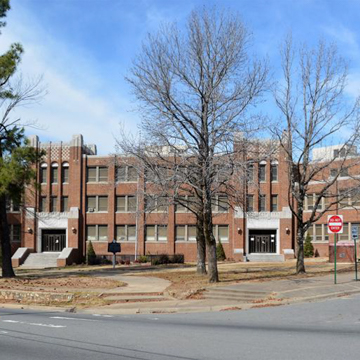Wittenberg and Delony were members of the design team for Little Rock Central High School (PU44) two years previously, and the architectural influence of that school is clearly evident in the design of Dunbar, although Dunbar is smaller and less ornate. The three-story school’s central portion and the flanking classroom wings create an open court in front of the building. As at Central High, brick pilasters between the window bays accentuate the verticality of its Art Deco version of Collegiate Gothic, and both schools feature corridors with arched ceilings and similar finishes.
When Dunbar opened in 1929 (the school is named for African American author Paul Laurence Dunbar), it served as a junior high and senior high school and as a junior college for African American students, offering an academic curriculum as well as the traditional vocational programs. The school was one of two industrial arts schools in the South to attain junior college rating in 1931. Dunbar School is one of only a handful of buildings remaining in Arkansas that received funding from the Rosenwald Fund, which was established in 1917 by Julius Rosenwald, president of the Sears, Roebuck and Company to provide financial and technical assistance for the construction of schools for African Americans throughout the South between 1917 and 1932. The building remains in use as a magnet middle school.


